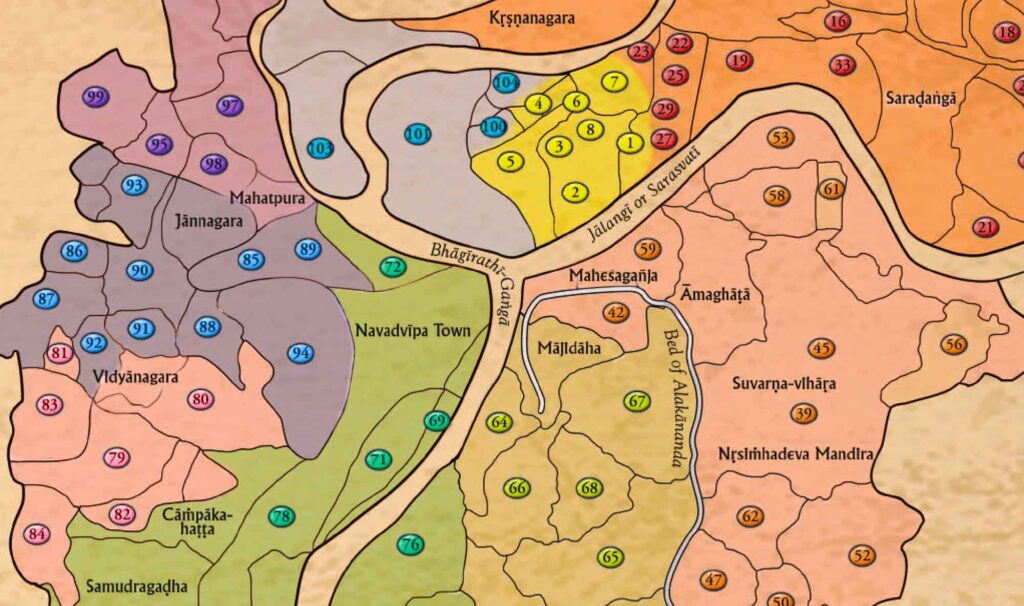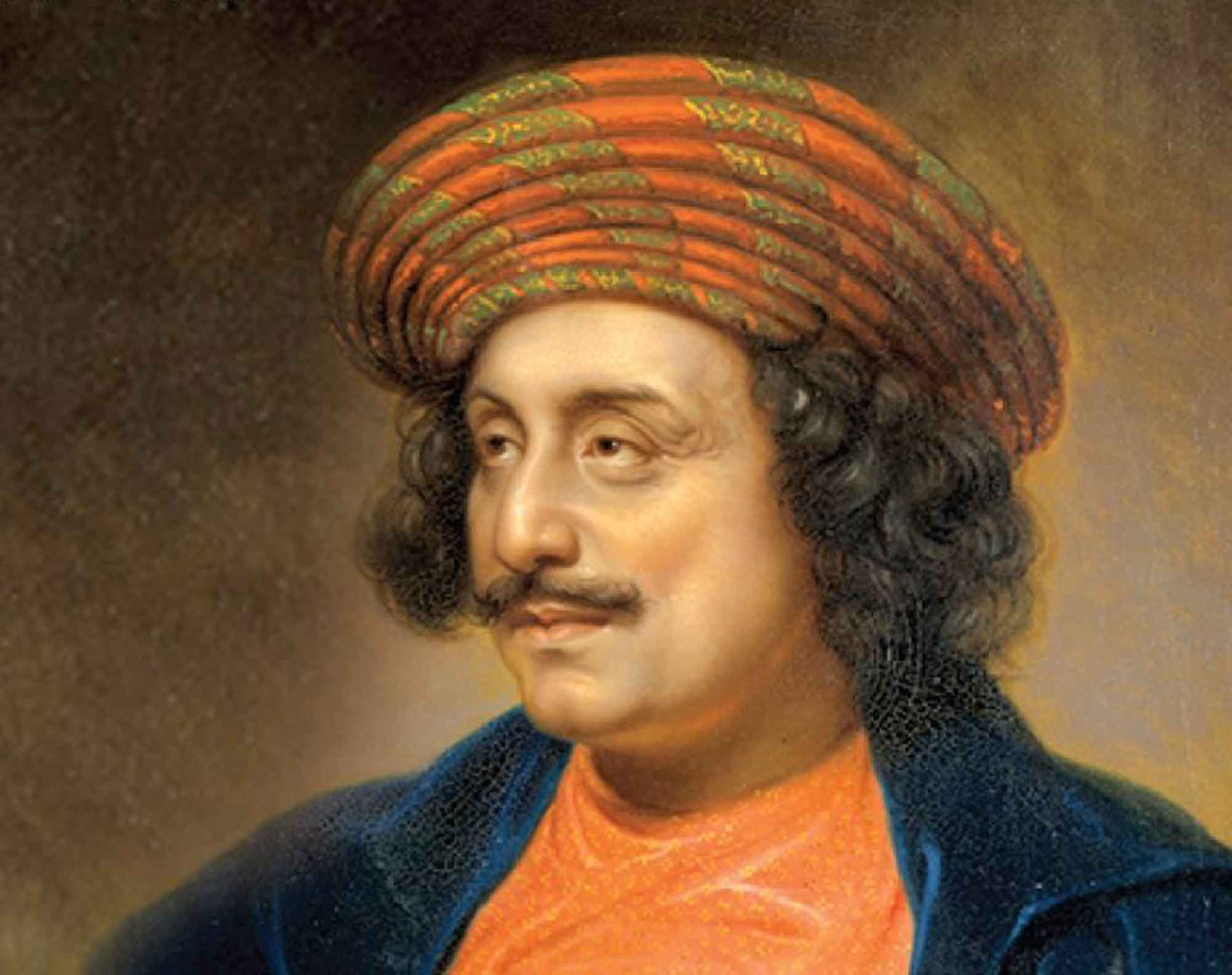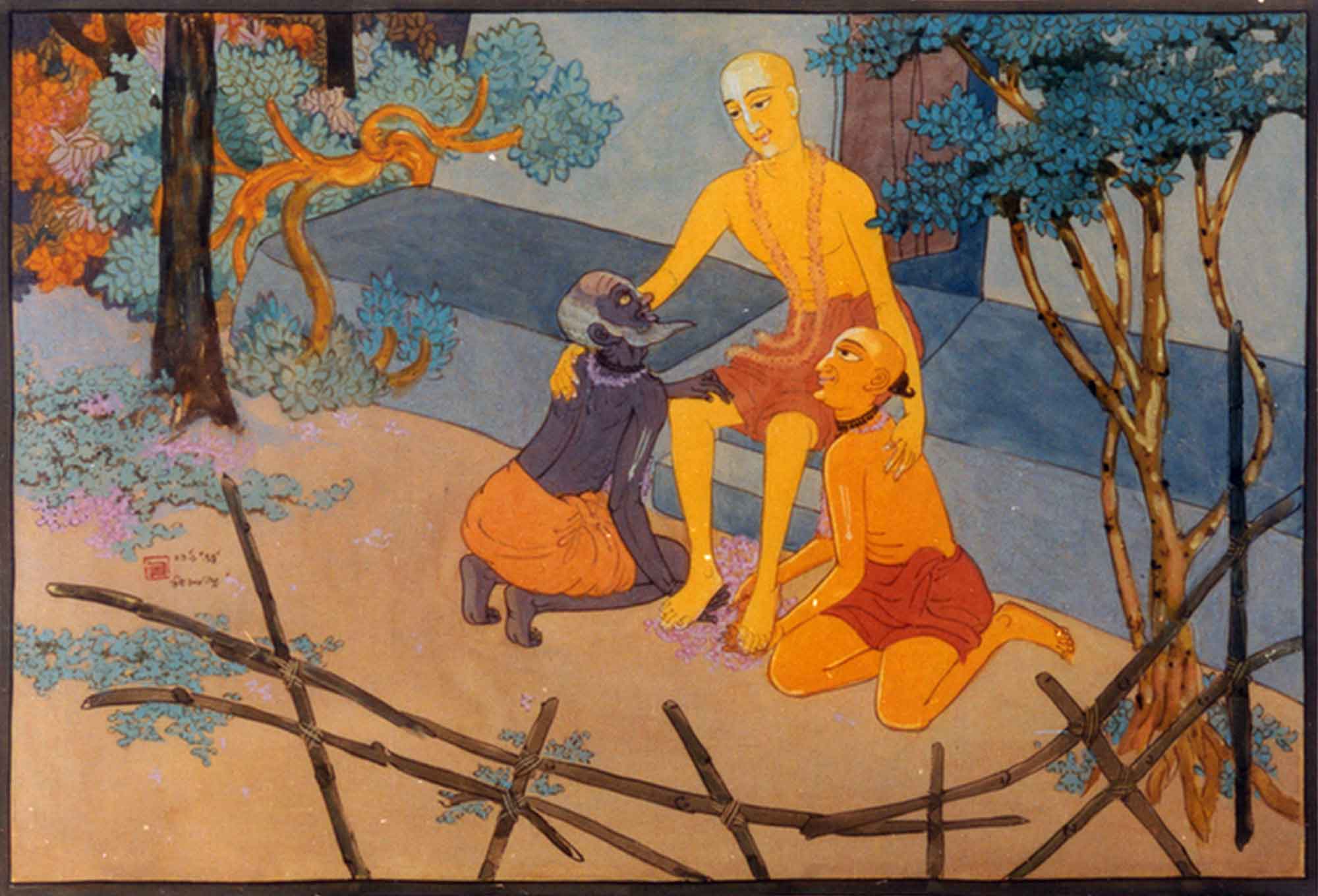Overview
Yāhāke Samprati Navadvīpa Balena Tāhāi Aparādha-bhañjanera Pāṭa Kuliyā (What is Presently Called Aparādha Bhañjanera Pāṭa in Kuliyā) was first published in Sajjana Toṣaṇi, Vol.7 issue 3 in 1895. This was a follow-up article from issue 2 describing the location of the town of Kuliyā in Navadvīpa.
(translated by Swami B.V. Giri)
In the previous article we saw how, due to the change in the flow of the Gaṅgā, Śrīdhāma Navadvīpa was previously on the east bank of the Gaṅgā, and Śrīpāṭa Kuliyā was on the western bank. Some sections of Kuliyā have been broken, some parts of it have been amalgamated into Navadvīpa Dhāma and some parts are still known as the village of Kuliyā. Many parts of Kuliyā are on sand banks. This is because, a long time ago, Gādigāchhā and Mājidā came close to eroding as the Gaṅgā flowed to the west, and at that time, sand banks in Kuliyā were formed. Many brāhmaṇas and non-brāhmaṇas built dwellings on that land which had become strong and high some time before Mahāprabhu. Places such as Tegharī, Baiciyāḍā, Bedaḍāpāḍā, Cinedaṅgā etc. became residences for people. The children of the famous Śrīkara Caṭṭopādhyāya came from Bilvagrāma and Pāṭuli and lived in some parts of Baiciyāḍā. Yudhiṣṭhira Caṭṭopādhyāya Mahāśaya had three sons – Chakaḍi, Tinkaḍi and Dokaḍi. Their actual names were Śrī Mādhava Dāsa Caṭṭu, Śrī Hari Dāsa Caṭṭu and Śrī Kṛṣṇa Sampati Caṭṭu, and they are considered to be famous personalities in the ancient Sanskrit book, Śrī Vaṁṣī-līlāmṛta. Gauracandra, the crest-jewel of sannyāsīs, came and stayed for seven days in the house of that Mādhava Dāsa Caṭṭu, and there He removed the offences of Devānanda, Gopāla Cāpāla and Kṛṣnānanda. Therefore, the name of Kuliyā became Aparādha Bhañjanera Pāṭa (the place where the Lord removed offences). In the book called Vaṁśī Śikṣā, it is written:
bhāgīrathī-taṭe ramye gauḍe puṇye navadvīpe
kuliyāyāṁ śubhe śāke rasendu-veda-candrame
śrī-vaṁśī-vadano yasyāṁ prakaṭo’bhūdṛijālaye
sarva-sad-guṇa-pūrṇāṁ tāt vande’haṁ madhu-pūrṇimāṁ
(“I offer my respects unto the full moon of the month of Madhu, because on that day, on the banks of the Gaṅgā, in the beautiful land of Gauḍa, in the pure land of Navadvīpa, in Kuliyā, in the auspicious Śaka era of 1416, Śrī Vaṁśīvadana appeared in this world.”)
cauda-śat-ṣola śake madhu pūrṇimāya
vaṁśīra prakaṭotsava hayata sandhyāya
(“In 1416 of the Śaka era on the full moon of the month of Madhu, the appearance festival of Vaṁśī-vadanānanda occurred during twilight.”)
nadīyāra mājha-khāne, sakala-lokete jñāne
kuliyā-pāhāḍa nāme sthāna
tathāya ānanda-dhāma, śrī-chakaḍi caṭṭa nāma
mahā-tejā kulīna santāna
(“In the middle of Nadīyā, is a place known to all people as Kuliyā Pāhāḍa. In that blissful place, one effulgent personality of noble birth resides named Śrī Chakaḍī Caṭṭa.”)
In this text, the village of Kuliyā is mentioned as being in the middle of Nadiyā. With this statement alone, the claim of Kuliyā near Sat Kuliyā, or Kāñcanpalli, is terminated. When it comes to researching ancient philosophy, one’s bias has to be zero. Deliberate upon what is written here in the esteemed Śrī Bhakti Ratnākara. In this book it is written:
atavā śrī-navadvīpe nava dvīpa-nāma
pṛthaka pṛthaka kintu haya eka grāma
pūrve antardvīpa śrī-sīmantadvīpa haya
godrumadvīpa śrī-madhyadvīpa catuṣṭaya
koladvīpa ṛtu jahnu modadruma āra
rudradvīpa ei pañca paścime pracāra
(“In Śrī Navadvīpa, each of the nine islands has a name. Although they are separate, they are one village. In the east there are four – Antardvīpa, Sīmantadvīpa Godrumadvīpa and Madhyadvīpa. Koladvīpa, Ṛtudvīpa, Jahnudvīpa, Modrumadvīpa and Rudradvīpa are the five that are on the western bank.”– Bhakti Ratnākara 12.51-52)
navadvīpa-madhye māyāpura-nāme sthāna
yathā janmilena gora-candra bhagavān
(“Within Navadvīpa is a place called Māyāpura. It is here that Bhagavāṇ Gora-candra took birth.” – Bhakti Ratnākara 12.83)
This description shows that a territory called Navadvīpa was then surrounded by Śrī Gaṅgā Devī. All the other surrounding villages were located within the 16 krośa perimeter of Navadvīpa. The author of Bhakti-Ratnākara describes how he saw with his own eyes the establishment of Śrī Navadvīpa-maṇḍala 250 years ago. That is many times better than the speculations of modern people and the honourable Śrī Narahari Ghanaśyāma Dāsa was a renounced Vaiṣṇava. He used to do bhajana sometimes in Śrī Vṛndāvana and sometimes in Śrī Navadvīpa. Therefore, he is impartial – whatever is found in his description should be accepted by an intelligent person. It is simply unfortunate for us to ignore his description, because none of our mental conceptions are fulfilled. In his book he speaks about Koladvīpa, situated on the west bank along with four other islands. Later, we will show evidence for the location of Navadvīpa, and where Māyāpura is within that. Let us point out the location of present day Kuliyā. Śrī Narahari Dāsa has written the following description of Śrīnivāsa Ācārya Prabhu’s dhāma-parikramā:
kuliyā-pāhāḍapura dekha śrinivāsa
pūrve koladvīpa parvatākhya e pracāra
(“O Śrīnivāsa, see the town of Kuliyā-Pāhāḍapura, which was previously known as Koladvīpa.”)
Let us try to understand from where Ācārya Prabhu went from to the town of Kuliyā. In the Parikramā Paddhati it is written:
bāmana-pukure puṇya-grāma, brāhmaṇa-puṣkara e vidita pūrva nāma
brāhmaṇera jāni manaḥ kathā, āilena ānande puṣkara-tīrtha tathā
e prasaṅga ati sumadhura, puṣkarera dvāre kṛpā haila prabhura
kuliyā-pāhāḍapura grāma, pūrve koladvīpa parvatākhyānanda-dhāma
prabhu-priya-bhakte koladvīpe, parvatera-prāya dekhā dilā kola-rūpe
(“The sacred village of Bāmana Pukura was previously known by the name Brāhmaṇa Puṣkara. Knowing the mind of the brāhmaṇas, this blissful holy lake manifested. These topics are most sweet. By this lake one can attain the mercy of the Lord. The village of Kuliyā-Pāhāḍapura was previously known as the hill of Koladvīpa which was the abode of bliss. To the Lord’s dear devotees in Koladvīpa He gave darśana in the form of a boar, which was like a mountain.”)
There can be no doubt that the village of Bāmanapura is Brāhmaṇa Puṣkara. This is because there are still signs of Puṣkara-tīrtha and Vaiṣṇavas take darśana and touch it during parikramā. Brāhmaṇa Puṣkara is on the east bank of the Gaṅgā and Kuliyā-Pāhāḍapura is on the west-bank of the Gaṅgā. Therefore, it is written in the Parikramā Paddhati:
jāhnavīra paścima-kulete, koladvīpādika pañca vikhyāta jagate
(“At the western bank of the Gaṅgā, these five including Koladvīpa are famous in this world.”)
There is no mention of crossing the Gaṅgā from Brāhmaṇapura to Kuliyā- Pāhāḍapura in the Parikramā Paddhati, but there is no doubt that Śrīnivāsa Ācārya Prabhu went from Koladvīpa to the Parṇaśīlā Ghāṭa from Brāhmaṇapura. Even today, if you cross that ghāṭa, you can go up to the village of Kuliyā. Ācārya Prabhu visited Kuliyā and went to Samudrāgaḍha. There is no mention of the Gaṅgā there. In fact, the Gaṅgā was not between Kuliyā and Samudrāgaḍha at that time. Only in the rainy season would the lowlands become waterlogged and one could traverse there. If someone goes from Māyāpura to Koladvīpa through the different villages after studying the Parikramā Paddhati, all his problems are solved. There is a similar description in the book, Vaiṣṇavācāra Darpaṇa. Some time after Śrīman Mahāprabhu, Kavi Kaṅkana wrote in his own book Caṇḍī:
tvarākari sadāgara rātri-dina yāya
pūrva-sthalī sadāgara bahiyā eḍāya
kothā-u randhana kothā dadhi-khaṇḍa-kalā
navadvīpe uttarila veniyāra bālā
caitanya-caraṇe sādhu karila vandana
sekhane rahiyā kaila randhana-bhojana
pāḍapura-samudragaḍhi rāhila melāna
mīrajāpure karile ḍiṅgara cāpāna
(“In a hurry the merchant’s day and night goes,
The merchant crosses Pūrva-sthalī while sailing away.
At some place he cooks, at some place he has curd, jaggery and bananas.
At Navadvīpa the merchant’s rice-filled boat unloaded.
At the feet of Caitanya the sādhu worshipped.
Staying there, he did his cooking and eating
He wandered around Pāḍapura and Samudragaḍhi.
In Mīrjāpura, he showed his cleverness in impulsively composing short songs against his opponents.”
At first, Dhanapati Sadāgara cooked and ate at Nadīyā Ghāṭa, then that place was called Dewan-Gañja. Viśārada’s dam and Śrīrāmapura are on the other side of Dewan-Gañja. Leaving that behind, you come to Pāhāḍapura in the south. Kavi Kaṅkana has written this Kuliyā-Pāhāḍapura as Pāḍapura. Leaving Pāḍapura he reached Samudrāgaḍha. That path can still be seen. By looking at the Peninsula map of Kasim Bazaar, all these doubts are dispelled. There can be no doubt that the village of Kuliyā is in present day Navadvīpa. Then, at that time, from Dewan-Gañja, keeping the Gaṅgā in Kuliyā to the south, he headed north towards Gaṅgānagara. It is not possible to determine if Nahalāpāḍā in present day Navadvīpa was within the Gaṅgā at that time. The old residents of Navadvīpa say that most of Nahalāpāḍā was in the Gaṅgā. When the water dried up, the dilapidated dwellings on the banks of Dewan-Gañja were inhabited by many tenants who came and lived on the sand banks of Kuliyā. As the Gaṅgā began to give up land on the banks of Dewan-Gañja, so did many other places in Puratana-Gañja, such as Bābālāḍi etc. which are situated in Śrī Navadvīpa. At that time, Śrīvāsa-aṅgana was imagined to be in a place in Puratana-Gañja. That is why it is on the banks of Kuliyā again. The tenants of Dewan-Gañja are all tenants of the town of Nadīyā. They propagated the name of ‘Navadvīpa’ all the way up to the adjacent sand banks. When a big name appears, the small name disappears. In a few villages in Kuliyā, the former famous name of Kuliyā became lost and the name of Navadvīpa was circulated. In order to establish such a Kuliyā, it was necessary to establish their own Navadvīpa. We will get to that later. For the aforesaid reasons, all neutral research fails if Śrī Kuliyā-pāṭa is not established in present day Navadvīpa. Cakaḍi-Mādhava Caṭṭa Mahāśaya and his son Prabhu Vaṁśīvadanānanda lived in the village of Kuliyā, and the descendants of Vaṁśīvadanānanda moved from Kuliyā in Śrī Māyāpura to Śrīpāṭa Bāghnāpāḍā with the wooden Deity of Śrīman Mahāprabhu. This is famous everywhere. In the western part of present day Navadvīpa, where the Gaṅgā flowed long before Śrīman Mahāprabhu, the city of Kuliyā could not be found by searching anywhere in the west. If Kuliyā had been there and such a major city had disappeared, some traces of it would have been found. We once heard from a very old professor from Samudrāgaḍha that he used to come to the market in the village of Kuliyā as a child and saw many parts of Kuliyā with his own eyes.













